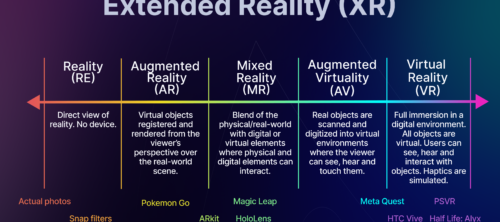
Understanding the Distinction Between AR and VR
Augmented Reality (AR) and Virtual Reality (VR) are two transformative technologies that are reshaping how we interact with digital content. While often mentioned together, these immersive technologies offer distinct experiences and applications. Let’s explore the key differences between AR and VR, their unique advantages, and the challenges they face.
Augmented Reality (AR): Enhancing the Real World
Augmented Reality overlays digital information onto the real world, enhancing our existing environment with computer-generated content. Unlike VR, AR allows users to maintain awareness of their physical surroundings while interacting with virtual elements.
Key Features of AR:
- Blends digital content with the real world
- Accessible through smartphones, tablets, or specialized AR glasses
- Maintains user’s connection to the physical environment
AR technology has gained significant traction in recent years, with industry analysts projecting substantial growth in the global AR market. This growth is driven by the technology’s versatility and its ability to enhance real-world experiences across various sectors.
Applications of AR:
- Retail: Virtual try-ons for clothing and makeup, revolutionizing online shopping experiences
- Education: Interactive learning experiences, bringing textbooks to life
- Navigation: Real-time directions and information overlays, enhancing travel experiences
- Gaming: Location-based games like Pokémon Go, blending virtual elements with real-world environments
- Industrial: Maintenance and repair guidance, improving efficiency in manufacturing and field service
Advantages of AR:
- More accessible to a wider audience due to smartphone compatibility
- Enhances real-world experiences rather than replacing them
- Lower risk of motion sickness compared to VR
- Easier to implement in everyday situations
- Facilitates social interaction and collaboration in shared spaces
AR’s ability to seamlessly integrate digital information into our physical world makes it particularly valuable for tasks that benefit from real-time, contextual information. For example, in healthcare, AR can assist surgeons by overlaying vital patient data during procedures, improving accuracy and reducing risks.
Challenges of AR:
- Limited field of view on current devices
- Potential for information overload
- Privacy concerns with constant environmental scanning
- Battery life limitations on mobile devices
- Developing intuitive user interfaces for diverse applications
Despite these challenges, AR continues to evolve rapidly. Advancements in 3D modeling for AR are enabling more realistic and interactive digital overlays, further blurring the line between the virtual and physical worlds.
Virtual Reality (VR): Immersion in a Digital World
Virtual Reality creates a fully immersive digital environment that replaces the user’s real-world surroundings. VR typically requires a headset that blocks out external stimuli, allowing users to interact solely with the virtual world.
Key Features of VR:
- Completely immerses users in a digital environment
- Requires specialized hardware like VR headsets
- Isolates users from their physical surroundings
- Offers six degrees of freedom (6DoF) for realistic movement tracking
VR technology has made significant strides in recent years, with improvements in display resolution, tracking accuracy, and content creation tools. These advancements have expanded VR’s applications beyond gaming and entertainment.
Applications of VR:
- Gaming: Fully immersive gaming experiences that transport players to new worlds
- Training and Simulation: Risk-free practice for complex tasks in fields like aviation and medicine
- Virtual Tourism: Exploring distant or inaccessible locations, preserving cultural heritage
- Therapy: Treatment for phobias, PTSD, and other mental health conditions
- Architecture and Design: Visualizing and interacting with 3D models before construction
Advantages of VR:
- Provides a fully immersive experience
- Ideal for scenarios requiring complete focus
- Enables experiences impossible in the real world
- Powerful tool for empathy-building and perspective-taking
- Offers unparalleled realism in simulations and training scenarios
The immersive nature of VR makes it particularly effective for applications that benefit from complete user engagement. For instance, VR-based training simulations can significantly reduce costs and risks associated with training in high-stakes environments like emergency response or surgical procedures.
Challenges of VR:
- Can cause motion sickness in some users
- Requires more expensive and specialized equipment
- Limited mobility due to headset and cables (though wireless solutions are emerging)
- Potential for addiction or escapism
- Social isolation during use
As VR technology continues to advance, many of these challenges are being addressed. For example, improvements in display technology and motion tracking are reducing instances of motion sickness, while the development of standalone VR headsets is increasing portability and accessibility.
The Future of AR and VR
As these technologies continue to evolve, we’re likely to see increased convergence and the rise of Mixed Reality (MR) experiences. MR combines elements of both AR and VR, allowing virtual objects to interact with the real world in more sophisticated ways.
The future of XR (Extended Reality) technologies, including AR and VR, promises to revolutionize industries such as healthcare, education, and entertainment. As hardware becomes more sophisticated and content creation tools more accessible, we can expect to see even more innovative applications emerge.
One exciting development is the potential for AR and VR to work in tandem, creating seamless transitions between augmented and fully immersive experiences. This could lead to new forms of storytelling, collaborative work environments, and educational experiences that blend the best aspects of both technologies.
Conclusion
While AR and VR share the goal of creating immersive digital experiences, they approach this in fundamentally different ways. AR enhances our existing reality, making it ideal for applications that benefit from real-world context. VR, on the other hand, transports us to entirely new worlds, perfect for scenarios requiring complete immersion.
As these technologies continue to advance, they will undoubtedly play an increasingly important role in how we work, learn, and interact with the world around us. Whether you’re designing 3D models for AR or creating fully immersive VR experiences, understanding the unique strengths and challenges of each technology is crucial for leveraging their full potential.
By embracing both AR and VR, we open up a world of possibilities for creating richer, more engaging digital experiences that seamlessly blend the virtual and physical worlds. As we move forward, the line between reality and digital augmentation will continue to blur, offering exciting new opportunities for innovation and creativity across all industries.
The future of AR and VR is not just about technological advancement; it’s about reimagining how we interact with information, each other, and the world around us. As these technologies mature, they have the potential to transform everything from how we learn and work to how we play and socialize, ushering in a new era of digital interaction that is more intuitive, immersive, and impactful than ever before.






